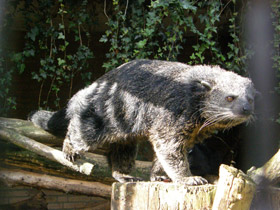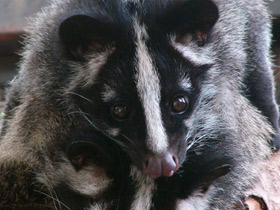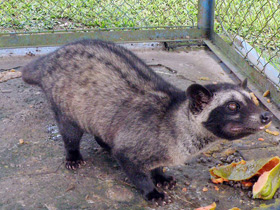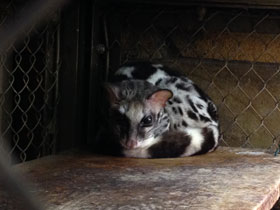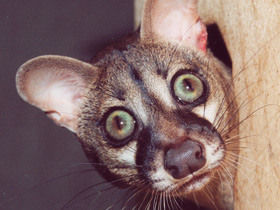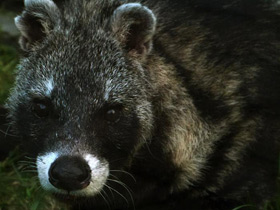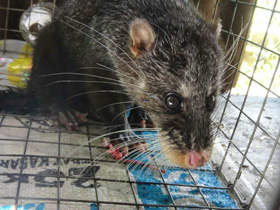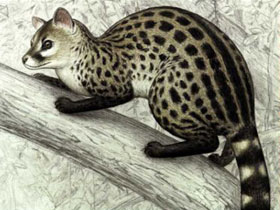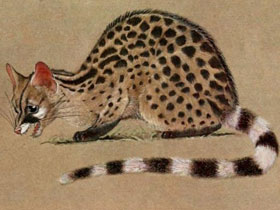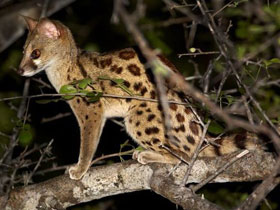The family Viverridae
Viverridae is a family of small to medium-sized, feliform mammals. The viverrids (/vaɪˈvɛrɪdz/) comprise 33 species placed in 14 genera. This family was named and first described by John Edward Gray in 1821. Viverrids occur all over Africa, southern Europe, and South and Southeast Asia, across the Wallace Line.
Almost all viverrids outside the subfamily Genettinae are commonly called civets, but some civets are not viverrids. Animals of the subfamily Genettinae are known as genets and oyans. The word viverridae comes from the Latin viverra 'ferret', but ferrets are in a different family, the Mustelidae.
Description
Viverrids are generally small, slender animals with short legs and long tails that live in trees.
They resemble cats, but have a muzzle similar to mongooses. Some of them have an external appearance reminiscent of polecats, while others resemble cats. Their body length varies from 30 to 98 cm, tail length from 12 to 90 cm and weight from 1 to 15 kg.
The body is long, muscular and flexible; the neck is of medium length, the head is small and has a long, tapering muzzle; the ears are short and wide set; the eyes are large and the limbs have five toes, for walking or stooping.
The wyvern's coat is usually short and rather rough, often brown with mottled patterns of stripes and spots. The tail is usually ring-shaped.
Some genera (Civettictis, Viverra, Viverricula) have special glands located in the anal region and secrete an odorous secretion called cibetina.
Habitat and way of life
Viverridae inhabit the Old World tropics: southern Europe (Iberian Peninsula), Africa and south and southeast Asia. The Himalayan Civet has acclimatised to Japan. They are found mainly in forests, shrubs and tall grasses.
These animals are active at night; during the day they take refuge in tree hollows, caves and, more rarely, in burrows, usually occupying the burrows of others. Some live in human buildings. Representatives of the family are the best tree climbers of all predators; some species spend most of their lives in trees. Most Viverridae are omnivorous, with a diet consisting of animal and plant foods: various small vertebrates and invertebrates, fruits, nuts and bulbs. Some species eat carrion.
Reproduction
Most species of Viverridae have no seasonality in reproduction. Pregnancy may last 60 to 80 days in different species. The litter contains 1 to 6 blind, but wool-covered calves. Some species have two litters per year.
Particularities
Many Viverridae are hunted and bred in captivity. They are hunted for their fluffy fur and edible meat, but especially for their cibetin, which is used in perfumery and medicine. One of the civets' favourite foods is coffee berries. In Indonesia, one of the most expensive types of coffee, Kopi Luwak, is obtained from seeds that have passed through the animal's digestive tract.
Living species
In 1821, Gray defined this family as consisting of the genera Viverra, Genetta, Herpestes, and Suricata. Reginald Innes Pocock later redefined the family as containing a great number of highly diversified genera, and being susceptible of division into several subfamilies, based mainly on the structure of the feet and of some highly specialized scent glands, derived from the skin, which are present in most of the species and are situated in the region of the external generative organs. He subordinated the subfamilies Hemigalinae, Paradoxurinae, Prionodontinae, and Viverrinae to the Viverridae.
In 1833, Edward Turner Bennett described the Malagasy fossa (Cryptoprocta ferox) and subordinated the Cryptoprocta to the Viverridae. A molecular and morphological analysis based on DNA/DNA hybridization experiments suggests that Cryptoprocta does not belong within Viverridae, but is a member of the Eupleridae.
The African palm civet (Nandinia binotata) resembles the civets of the Viverridae, but is genetically distinct and belongs in its own monotypic family, the Nandiniidae. There is little dispute that the Poiana species are viverrids.
DNA analysis based on 29 Carnivora species, comprising 13 Viverrinae species and three species representing Paradoxurus, Paguma and Hemigalinae, confirmed Pocock's assumption that the African linsang Poiana represents the sister group of the genus Genetta. The placement of Prionodon as the sister group of the family Felidae is strongly supported, and it was proposed that the Asiatic linsangs be placed in the monogeneric family Prionodontidae.
Family Viverridae:
- Subfamily Paradoxurinae:
- Genus Arctictis:
- Arctictis binturong;
- Genus Arctogalidia:
- Arctogalidia trivirgata;
- Genus Macrogalidia:
- Macrogalidia musschenbroekii;
- Genus Paguma:
- Paguma larvata;
- Genus Paradoxurus:
- Paradoxurus hermaphroditus;
- Paradoxurus jerdoni;
- Paradoxurus zeylonensis.
- Subfamily Hemigalinae:
- Genus Chrotogale:
- Chrotogale owstoni;
- Genus Cynogale:
- Cynogale bennettii;
- Genus Diplogale:
- Diplogale hosei;
- Genus Hemigalus:
- Hemigalus derbyanus.
- Subfamily Prionodontinae:
- Genus Prionodon:
- Prionodon linsang;
- Prionodon pardicolor.
- Subfamily Viverrinae:
- Genus Civettictis:
- Civettictis civetta;
- Genus Genetta:
- Genetta abyssinica;
- Genetta angolensis;
- Genetta bourloni;
- Genetta cristata;
- Genetta genetta genetta;
- Genetta johnstoni;
- Genetta maculata;
- Genetta pardina;
- Genetta piscivora;
- Genetta poensis;
- Genetta servalina;
- Genetta thierryi;
- Genetta tigrina;
- Genetta victoriae;
- Genus Poiana:
- Poiana leightoni;
- Poiana richardsonii;
- Genus Viverra:
- Viverra civettina;
- Viverra megaspila;
- Viverra tangalunga;
- Viverra zibetha;
- Genus Viverricula:
- Viverricula indica.

















